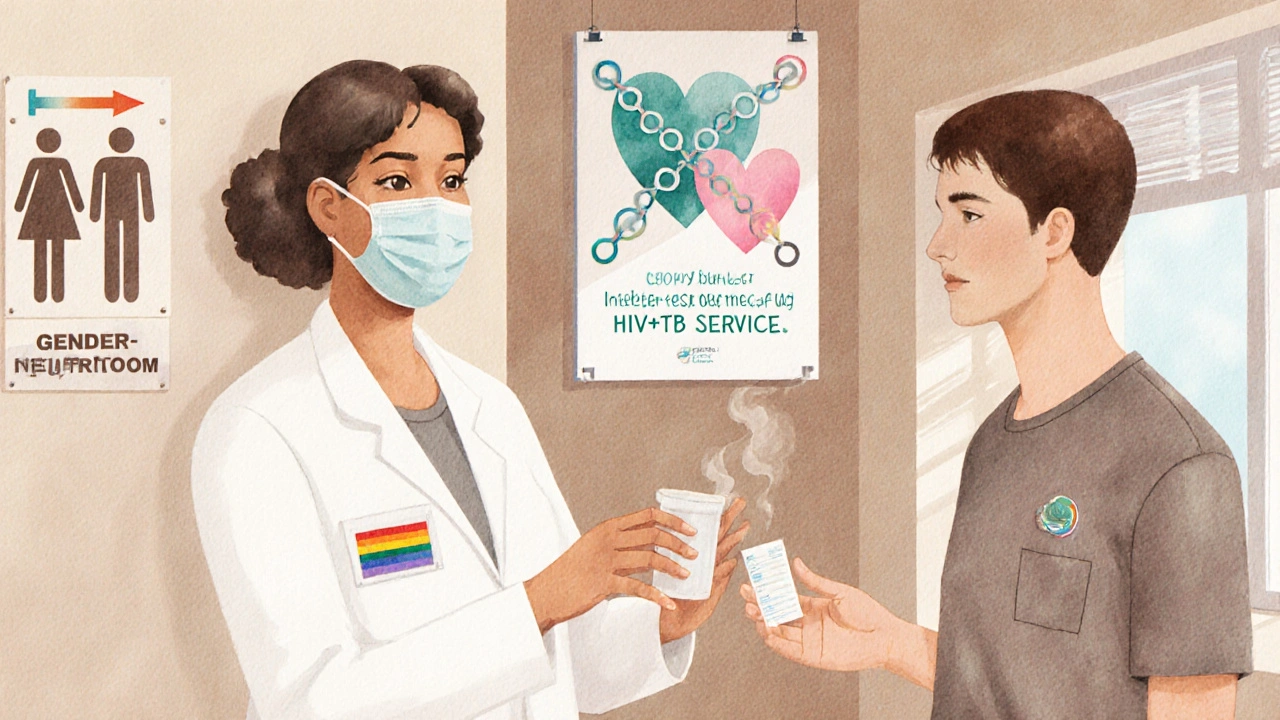TB Risk Calculator for LGBTQ+ Community
Your TB Risk Assessment
Risk Results
Based on the information you provided, your TB risk is low. This is consistent with the general population rate of 6.3 per 100,000.
Remember: TB can be prevented with early detection and proper treatment. Regular screening is recommended for those at higher risk.
Key Risk Factors
When it comes to infectious diseases, Tuberculosis and LGBTQ+ health rarely make the front page, yet the overlap creates a hidden crisis. People who identify as lesbian, gay, bisexual, transgender, queer, or other non‑heteronormative orientations often face higher exposure, delayed diagnosis, and poorer outcomes when TB strikes. This article breaks down why that happens, what the numbers show, and how communities and policymakers can turn the tide.
What is Tuberculosis?
Tuberculosis is a contagious bacterial infection caused by Mycobacterium tuberculosis. It mainly attacks the lungs, but it can spread to other organs. According to the World Health Organization, roughly 10 million people fell ill with TB in 2023, and 1.5million died worldwide. The disease spreads through airborne droplets, making crowded living spaces and poor ventilation high‑risk environments.
Understanding the LGBTQ+ Community
LGBTQ+ community refers to individuals whose sexual orientation, gender identity, or expression differs from the heterosexual, cisgender majority. The community encompasses a diverse range of people-from gay men and lesbian women to non‑binary and intersex individuals. Social research shows that LGBTQ+ members often experience discrimination in healthcare, housing, and employment, which amplifies vulnerability to infections like TB.
Why the Overlap Matters: Unique Risk Factors
Several intersecting factors push TB rates higher for LGBTQ+ people:
- Stigma and discrimination: Fear of judgment can keep people from seeking testing or treatment.
- Higher HIV co‑infection: HIV weakens the immune system, making TB activation more likely.
- Housing instability: Homelessness or living in communal shelters raises exposure to airborne pathogens.
- Limited culturally competent care: Few clinics have staff trained to address both TB and LGBTQ+ health concerns.

Current Data: Incidence and Trends
Data specific to sexual minorities is sparse, but several studies shed light on the pattern. In a 2022 survey of gay and bisexual men in urban Australia, TB prevalence was 1.8times higher than the national average. In the United States, the Centers for Disease Control reported that transgender women experience TB rates comparable to people living with HIV-about 25cases per 100,000 versus 6per 100,000 in the general population.
Co‑infection with HIV remains a major driver. The World Health Organization estimates that 15% of TB patients worldwide are also HIV‑positive, a proportion that climbs to 30% within some LGBTQ+ sub‑groups.
Drug‑resistant forms add another layer of complexity. Drug‑resistant TB (DR‑TB) accounts for roughly 500,000 new cases each year, and treatment success drops below 60%. LGBTQ+ individuals facing barriers to consistent medication are at higher risk of developing DR‑TB.
Barriers to Diagnosis and Treatment
Even when symptoms appear-persistent cough, night sweats, weight loss-many LGBTQ+ patients delay seeking help. The reasons are often personal and systemic:
- Fear of discrimination: Past negative experiences with clinicians can make people avoid medical settings.
- Lack of targeted screening: Public health campaigns seldom address sexual minorities, so TB testing isn’t offered proactively.
- Economic obstacles: Unstable employment leads to gaps in health insurance, limiting access to diagnostics like sputum culture or GeneXpert.
- Complex medication regimens: Standard TB therapy requires six months of multiple drugs; adherence drops when patients lack supportive services.
These gaps result in late-stage disease, higher transmission rates, and increased mortality.
Effective Interventions: Community‑Focused Strategies
Targeted programs can narrow the disparity gap. Successful models share three core elements: culturally safe spaces, integrated services, and peer support.
- Culturally safe spaces: Clinics that display LGBTQ+ inclusive signage, provide gender‑neutral bathrooms, and train staff in respectful communication see higher testing uptake.
- Integrated HIV‑TB services: Co‑locating HIV counseling, antiretroviral therapy, and TB screening reduces missed diagnoses. In Sydney’s inner‑west, a pilot program reported a 40% increase in TB case detection among gay men.
- Peer navigation: Trained community members accompany patients through the diagnostic process, remind them of medication doses, and help navigate insurance paperwork.
Vaccination also plays a role. The BCG vaccine (Bacillus Calmette‑Guérin) offers limited protection against pulmonary TB in adults but is effective against severe childhood TB. Some LGBTQ+ health centers now offer BCG as part of routine immunizations for at‑risk youth.

Policy Recommendations and Future Outlook
Addressing TB in the LGBTQ+ community requires systemic change.
- Data collection: Public health agencies should include sexual orientation and gender identity fields in TB registries, while ensuring privacy.
- Funding for inclusive clinics: Grants earmarked for LGBTQ+ health can support staff training, outreach events, and tele‑health platforms.
- National guidelines: The Australian Government’s National Tuberculosis Strategy 2024‑2030 could add a dedicated chapter on sexual minorities, mirroring WHO’s recent guidance on “key populations.”
- Research investment: More longitudinal studies are needed to quantify TB incidence within diverse LGBTQ+ sub‑groups and evaluate intervention efficacy.
When policies align with community needs, the cascade-from early detection to successful treatment-shortens dramatically.
Quick Checklist for Healthcare Providers
Use this short list during patient visits to improve TB care for LGBTQ+ individuals:
- Ask about sexual orientation and gender identity in a non‑judgmental way.
- Screen for TB symptoms in anyone with HIV, recent homelessness, or incarceration history.
- Offer rapid molecular testing (e.g., GeneXpert) for faster diagnosis.
- Discuss the BCG vaccine for at‑risk youth, especially in high‑TB regions.
- Connect patients with peer navigators or LGBTQ+ support groups.
- Document treatment adherence and address side‑effects promptly.
Comparison of TB Indicators: General Population vs. LGBTQ+ Sub‑Groups (2023)
| Metric | General Population | Gay & Bisexual Men (Urban Australia) | Transgender Women (US Cities) |
|---|---|---|---|
| Incidence (per 100,000) | 6.3 | 11.5 | 25.0 |
| HIV Co‑infection % | 10 | 28 | 45 |
| Drug‑Resistant TB % | 3.2 | 5.8 | 9.1 |
| Treatment Completion % | 84 | 66 | 58 |
Frequently Asked Questions
Is TB more common in the LGBTQ+ community?
Studies show higher incidence rates among gay, bisexual, and transgender populations, largely due to overlapping risk factors such as HIV co‑infection, housing instability, and reduced access to culturally safe healthcare.
Can the BCG vaccine protect LGBTQ+ individuals?
BCG offers limited protection against adult pulmonary TB but is effective against severe childhood forms. Offering it in LGBTQ+ health centers can reduce early‑life TB risk, especially for at‑risk youth.
What should I do if I suspect I have TB?
Seek a healthcare provider who offers confidential testing. Request a sputum smear or rapid molecular test, and disclose any HIV status or housing concerns that might affect treatment planning.
How can community groups help?
Groups can organize free screening events, train peer navigators, and lobby for inclusive policies that mandate data collection on sexual orientation and gender identity.
Are there specific guidelines for treating TB in LGBTQ+ patients?
While the clinical regimen is the same, guidelines stress the need for culturally competent care, integrated HIV‑TB services, and flexible delivery models (e.g., tele‑health, community DOT) to improve adherence.


Post A Comment